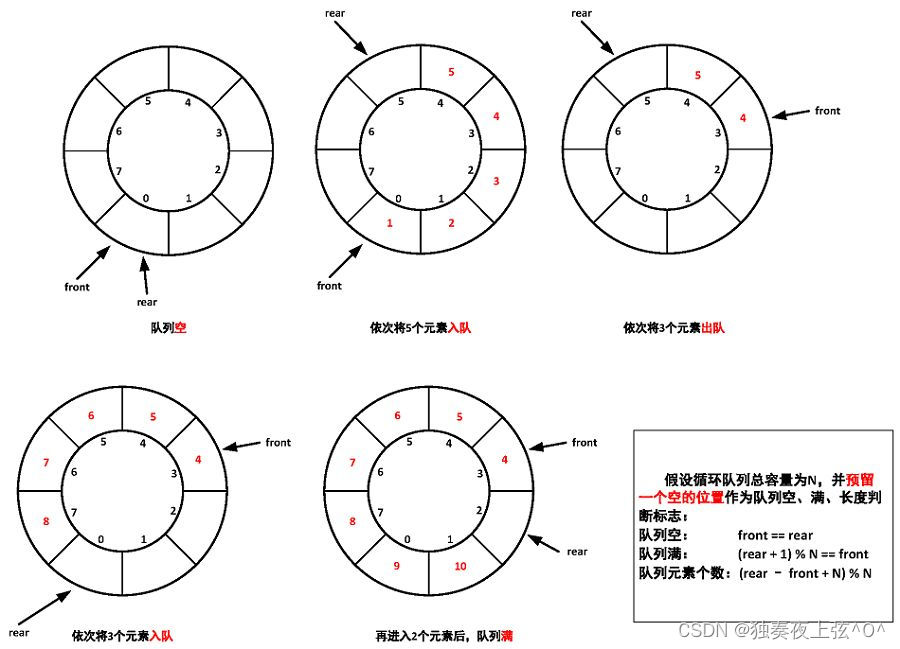今天内容比较简单~
一、队列的定义
队列:队列是只允许在一端进行插入操作,而在另一端进行删除操作的线性表
二、队列的抽象数据类型
ADT Queue{
数据对象:D={ai|ai∈ElemSet, i=1,2, …,n, n≥0}
数据关系:R1={<ai-1,ai>|ai-1,ai∈D, i=1,2, …,n }
约定a1为队列头,an为队列尾。
基本操作:
InitQueue( &Q )
操作结果:构造一个空队列Q。
DestroyQueue ( &Q )
初始条件:队列Q已存在。
操作结果:销毁队列Q。
ClearQueue ( &Q )
初始条件:队列Q已存在。
操作结果:将Q清为空队列。
QueueEmpty( Q )
初始条件:队列Q已存在。
操作结果:若Q为空队列,则返回TRUE,否则返回FALSE。
QueueLength( Q )
初始条件:队列Q已存在。
操作结果:返回Q的数据元素个数,即队列的长度。
GetHead( Q, &e )
初始条件:队列Q已存在且非空。
操作结果:用e返回Q的队头元素。
EnQueue( &Q, e )
初始条件:队列Q已存在。
操作结果:插入元素e为Q的新的队尾元素。
DeQueue( &Q, &e )
初始条件:队列Q已存在且非空。
操作结果:删除Q的队头元素,并用e返回其值。
QueueTraverse( Q, visit() )
初始条件:队列Q已存在且非空。
操作结果:从队头到队尾依次对Q的每个数据元素调用函数visit()。一旦visit()失败,则操作失败。
}ADT Queue
三、循环队列(C语言)
如果使用队列的顺序存储结构,我们来想想有什么不足?
由于这是一个线性表,我们在队尾进行添加并没有什么问题,但是当我们在队首出队一个元素之后,后面的元素都需要向前挪动一个位置,此时的时间复杂度是n,因此,我们需要寻找一种方法来弥补这种不足。
队首元素不一定存储在0下标的位置可以解决上述问题吗?会不会产生新的问题?
我们如果让出队的元素出队后,后面的元素不移动,可以解决上述问题,但是,这会产生一个新的问题,当最后一个元素的位置已经位于数组的最后,再插入一个新的元素,那么这个新的元素将无法插入进去,会报数组越界的错误。
循环队列:
上述问题,都可以用循环队列来进行解决,让存储的时候,存储到末尾的时候又从头开始添加

由上面的图我们可以知道,循环队列需要一个头指针和尾指针进行标识,front为头指针,rear为尾指针。下面来讨论几种方法的实现
如何判断队列为空:
若头指针和尾指针相同,则判断为空,即front==rear
如何判断队列为满:
若队列为满,也会出现front=rear的情况,为了与队列为空的时候区别开来,我们可以保留一个空位,这个空位不存放元素,如果队列内除了这个元素其他元素都满了,则说明队列已经满了。可以看上面那个图。
队列满的条件:
(rear+2)%QueueSize==front
如何计算队列长度:
(rear-front+QueueSize)%QueueSize
#include "stdio.h"
#include "stdlib.h"
#include "math.h"
#include "time.h"
#define OK 1
#define ERROR 0
#define TRUE 1
#define FALSE 0
#define MAXSIZE 20 /* 存储空间初始分配量 */
typedef int Status;
typedef int QElemType; /* QElemType类型根据实际情况而定,这里假设为int */
/* 循环队列的顺序存储结构 */
typedef struct
{
QElemType data[MAXSIZE];
int front; /* 头指针 */
int rear; /* 尾指针,若队列不空,指向队列尾元素的下一个位置 */
}SqQueue;
Status visit(QElemType c)
{
printf("%d ",c);
return OK;
}
/* 初始化一个空队列Q */
Status InitQueue(SqQueue *Q)
{
Q->front=0;
Q->rear=0;
return OK;
}
/* 将Q清为空队列 */
Status ClearQueue(SqQueue *Q)
{
Q->front=Q->rear=0;
return OK;
}
/* 若队列Q为空队列,则返回TRUE,否则返回FALSE */
Status QueueEmpty(SqQueue Q)
{
if(Q.front==Q.rear) /* 队列空的标志 */
return TRUE;
else
return FALSE;
}
/* 返回Q的元素个数,也就是队列的当前长度 */
int QueueLength(SqQueue Q)
{
return (Q.rear-Q.front+MAXSIZE)%MAXSIZE;
}
/* 若队列不空,则用e返回Q的队头元素,并返回OK,否则返回ERROR */
Status GetHead(SqQueue Q,QElemType *e)
{
if(Q.front==Q.rear) /* 队列空 */
return ERROR;
*e=Q.data[Q.front];
return OK;
}
/* 若队列未满,则插入元素e为Q新的队尾元素 */
Status EnQueue(SqQueue *Q,QElemType e)
{
if ((Q->rear+1)%MAXSIZE == Q->front) /* 队列满的判断 */
return ERROR;
Q->data[Q->rear]=e; /* 将元素e赋值给队尾 */
Q->rear=(Q->rear+1)%MAXSIZE;/* rear指针向后移一位置, */
/* 若到最后则转到数组头部 */
return OK;
}
/* 若队列不空,则删除Q中队头元素,用e返回其值 */
Status DeQueue(SqQueue *Q,QElemType *e)
{
if (Q->front == Q->rear) /* 队列空的判断 */
return ERROR;
*e=Q->data[Q->front]; /* 将队头元素赋值给e */
Q->front=(Q->front+1)%MAXSIZE; /* front指针向后移一位置, */
/* 若到最后则转到数组头部 */
return OK;
}
/* 从队头到队尾依次对队列Q中每个元素输出 */
Status QueueTraverse(SqQueue Q)
{
int i;
i=Q.front;
while((i+Q.front)!=Q.rear)
{
visit(Q.data[i]);
i=(i+1)%MAXSIZE;
}
printf("\n");
return OK;
}
int main()
{
Status j;
int i=0,l;
QElemType d;
SqQueue Q;
InitQueue(&Q);
printf("初始化队列后,队列空否?%u(1:空 0:否)\n",QueueEmpty(Q));
printf("请输入整型队列元素(不超过%d个),-1为提前结束符: ",MAXSIZE-1);
do
{
/* scanf("%d",&d); */
d=i+100;
if(d==-1)
break;
i++;
EnQueue(&Q,d);
}while(i<MAXSIZE-1);
printf("队列长度为: %d\n",QueueLength(Q));
printf("现在队列空否?%u(1:空 0:否)\n",QueueEmpty(Q));
printf("连续%d次由队头删除元素,队尾插入元素:\n",MAXSIZE);
for(l=1;l<=MAXSIZE;l++)
{
DeQueue(&Q,&d);
printf("删除的元素是%d,插入的元素:%d \n",d,l+1000);
/* scanf("%d",&d); */
d=l+1000;
EnQueue(&Q,d);
}
l=QueueLength(Q);
printf("现在队列中的元素为: \n");
QueueTraverse(Q);
printf("共向队尾插入了%d个元素\n",i+MAXSIZE);
if(l-2>0)
printf("现在由队头删除%d个元素:\n",l-2);
while(QueueLength(Q)>2)
{
DeQueue(&Q,&d);
printf("删除的元素值为%d\n",d);
}
j=GetHead(Q,&d);
if(j)
printf("现在队头元素为: %d\n",d);
ClearQueue(&Q);
printf("清空队列后, 队列空否?%u(1:空 0:否)\n",QueueEmpty(Q));
return 0;
}
四、循环队列(Java)
Java中其实封装好了很多数据结构,但是我们为什么要自己再写一遍呢?如果我们遇到Java中的数据额结构无法满足生产需求的时候,我们这种时候就可以自己根据需求写一个数据结构来使用,但是这种情况下,往往容易出现一些未知的错误,因此,一般非特殊情况并不推荐使用自己写的数据结构。下面是自己写的一个代码。也可以进行泛型化,这样更接近源码。
package Text;
// 栈的链式存储:优点是不存在栈满的情况
public class LinkStack {
private Node header = new Node(); // 创建头节点
class Node {
String value;
Node next;
}
public boolean push(String value) {
Node n = new Node();
n.value = value;
if(header.next == null) {
header.next = n;
return true;
}
n.next = header.next;
header.next = n;
return true;
}
public boolean pop() {
if(header.next == null) {
return false;
}
header.next = header.next.next;
return true;
}
public String getTop() {
if(header.next != null) {
return header.next.value;
}
return null;
}
public boolean isEmpty() {
return header.next == null ? true : false;
}
}
五、队列的链式存储结构的实现(C语言、Java)
相比于循环队列,其实队列的链式存储结构更加简单,它没有存储空间限制,并且也没有元素移动问题,操作与实现上与线性表是一模一样的。
上代码:
#include "stdio.h"
#include "stdlib.h"
#include "math.h"
#include "time.h"
#define OK 1
#define ERROR 0
#define TRUE 1
#define FALSE 0
#define MAXSIZE 20 /* 存储空间初始分配量 */
typedef int Status;
typedef int QElemType; /* QElemType类型根据实际情况而定,这里假设为int */
typedef struct QNode /* 结点结构 */
{
QElemType data;
struct QNode *next;
}QNode,*QueuePtr;
typedef struct /* 队列的链表结构 */
{
QueuePtr front,rear; /* 队头、队尾指针 */
}LinkQueue;
Status visit(QElemType c)
{
printf("%d ",c);
return OK;
}
/* 构造一个空队列Q */
Status InitQueue(LinkQueue *Q)
{
Q->front=Q->rear=(QueuePtr)malloc(sizeof(QNode));
if(!Q->front)
exit(OVERFLOW);
Q->front->next=NULL;
return OK;
}
/* 销毁队列Q */
Status DestroyQueue(LinkQueue *Q)
{
while(Q->front)
{
Q->rear=Q->front->next;
free(Q->front);
Q->front=Q->rear;
}
return OK;
}
/* 将Q清为空队列 */
Status ClearQueue(LinkQueue *Q)
{
QueuePtr p,q;
Q->rear=Q->front;
p=Q->front->next;
Q->front->next=NULL;
while(p)
{
q=p;
p=p->next;
free(q);
}
return OK;
}
/* 若Q为空队列,则返回TRUE,否则返回FALSE */
Status QueueEmpty(LinkQueue Q)
{
if(Q.front==Q.rear)
return TRUE;
else
return FALSE;
}
/* 求队列的长度 */
int QueueLength(LinkQueue Q)
{
int i=0;
QueuePtr p;
p=Q.front;
while(Q.rear!=p)
{
i++;
p=p->next;
}
return i;
}
/* 若队列不空,则用e返回Q的队头元素,并返回OK,否则返回ERROR */
Status GetHead(LinkQueue Q,QElemType *e)
{
QueuePtr p;
if(Q.front==Q.rear)
return ERROR;
p=Q.front->next;
*e=p->data;
return OK;
}
/* 插入元素e为Q的新的队尾元素 */
Status EnQueue(LinkQueue *Q,QElemType e)
{
QueuePtr s=(QueuePtr)malloc(sizeof(QNode));
if(!s) /* 存储分配失败 */
exit(OVERFLOW);
s->data=e;
s->next=NULL;
Q->rear->next=s; /* 把拥有元素e的新结点s赋值给原队尾结点的后继,见图中① */
Q->rear=s; /* 把当前的s设置为队尾结点,rear指向s,见图中② */
return OK;
}
/* 若队列不空,删除Q的队头元素,用e返回其值,并返回OK,否则返回ERROR */
Status DeQueue(LinkQueue *Q,QElemType *e)
{
QueuePtr p;
if(Q->front==Q->rear)
return ERROR;
p=Q->front->next; /* 将欲删除的队头结点暂存给p,见图中① */
*e=p->data; /* 将欲删除的队头结点的值赋值给e */
Q->front->next=p->next;/* 将原队头结点的后继p->next赋值给头结点后继,见图中② */
if(Q->rear==p) /* 若队头就是队尾,则删除后将rear指向头结点,见图中③ */
Q->rear=Q->front;
free(p);
return OK;
}
/* 从队头到队尾依次对队列Q中每个元素输出 */
Status QueueTraverse(LinkQueue Q)
{
QueuePtr p;
p=Q.front->next;
while(p)
{
visit(p->data);
p=p->next;
}
printf("\n");
return OK;
}
int main()
{
int i;
QElemType d;
LinkQueue q;
i=InitQueue(&q);
if(i)
printf("成功地构造了一个空队列!\n");
printf("是否空队列?%d(1:空 0:否) ",QueueEmpty(q));
printf("队列的长度为%d\n",QueueLength(q));
EnQueue(&q,-5);
EnQueue(&q,5);
EnQueue(&q,10);
printf("插入3个元素(-5,5,10)后,队列的长度为%d\n",QueueLength(q));
printf("是否空队列?%d(1:空 0:否) ",QueueEmpty(q));
printf("队列的元素依次为:");
QueueTraverse(q);
i=GetHead(q,&d);
if(i==OK)
printf("队头元素是:%d\n",d);
DeQueue(&q,&d);
printf("删除了队头元素%d\n",d);
i=GetHead(q,&d);
if(i==OK)
printf("新的队头元素是:%d\n",d);
ClearQueue(&q);
printf("清空队列后,q.front=%u q.rear=%u q.front->next=%u\n",q.front,q.rear,q.front->next);
DestroyQueue(&q);
printf("销毁队列后,q.front=%u q.rear=%u\n",q.front, q.rear);
return 0;
}
下面是Java的代码
public class MyQueue {
private Node front;// 指向队列头元素的引用
private Node rear;// 指向队列尾元素的引用
private MyQueue() {
front = null;
rear = null;
}
public boolean isEmpty() {
// 指向队头元素的引用为空即队列为空
return front == null;
}
public void addQueue(Object item) {
// 创建一个要插入的新结点
Node newNode = new Node();
newNode.setData(item);
newNode.setNext(null);
if (isEmpty()) {
front = newNode;
rear = front;
} else {
rear.setNext(newNode);
rear = newNode;
}
}
public Object deleteQueue() throws Exception {
if (isEmpty()) {
throw new Exception("队列为空!");
} else {
Node delNode = front;
if (front == rear) {
front = rear = null;
} else {
front = front.getNext();
}
return delNode.getData();
}
}
}
六、总结
什么时候用循环队列,什么时候用链式队列?
在可以确定队列长度最大值的情况下,建议使用循环队列,如果无法确定队列的长度,则使用链队列